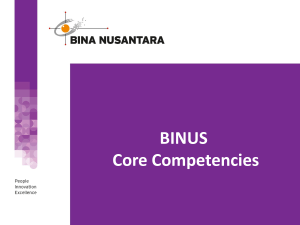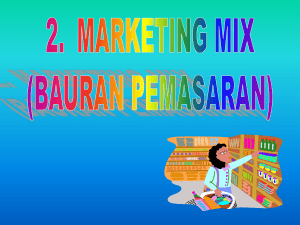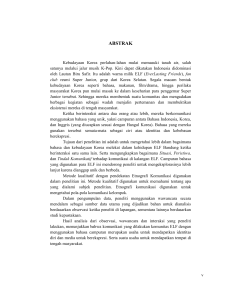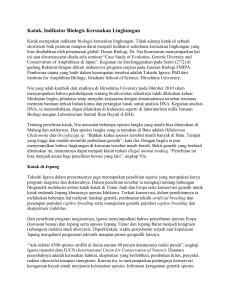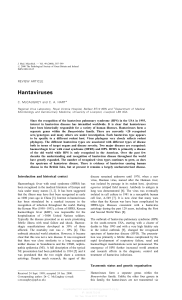chronic kidney disease
advertisement
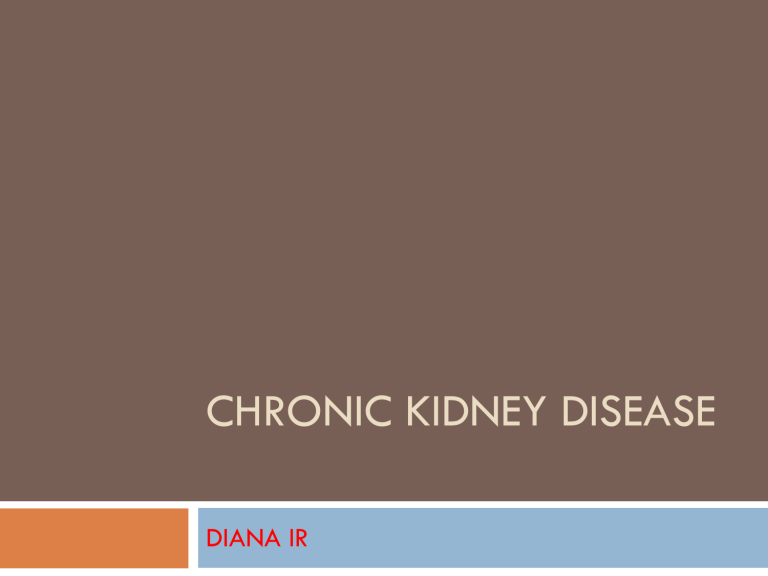
CHRONIC KIDNEY DISEASE DIANA IR EDUCATIONAL OBJECTIVE Define Chronic Kidney Disease Identify risk factors for progression and co-morbid conditions Discuss how early intervention improves outcomes during CKD progression Review measurements of kidney disease Nursing Diagnosis and Intervention CKD Is the progressive loss of renal function over months to years, advancement of the disease can sometimes be slowed, but it is ultimately irreversible and terminates in end-stage renal disease( Black 1999). Hilangnya kemampuan ginjal untuk mempertahankan volume dan komposis cairan tubuh dalam keadaan asupan diet normal ( Price 1999) Chronic Renal Failure CRF = CKD (chronic kidney disease) Is irreversible loss of renal function Classification : State GFR (ml/mn/1.73m2) 1 normal + persistent proteinuria 2 60-89 + persistent proteinuria 3 30-59 4 15-29 5 <15 or renal replacement therapy Persistent at least for 3 months ESRD : advanced CRF requiring dialysis or transplantation Menghitung GFR ♂: (140 – umur) x BB 72 x cr Wanita: ♂ x 0.85 (ml/mnt)☺ Etiology of ESRD DM 39% Hypertension + large vessel D GN, primary or secondary Hereditary cystic % congenital D Interstitial nephritis & Pyelonephritis Neoplasm / tumor Miscellaneous Missing 28 13 4 4 2 3 3 Sign and Symptoms General Fatigue & malaise Anorexia Edema Nausea/vomiting Musculoskeletal Osteodistrofi GI Skin Cardiac Pruritis Heart Pallor failure Pericarditis CAD Neurological MS changes Seizures Management of Clinical Problems Nutrition Protein : 0,6 – 0,75 gr/Kg/ day Kalori : 35 kal / Kg/ day Lemak : 30 – 40% KH : 50 – 60% Mineral Garam : 2-3 gr/day Kalsium :1400-1600 mg/day Kalium : 40-70meq/day Besi Fosfor Magnesium : 200-300mg/day : 5-10mg/day : 10-18 mg/day Management of Clinical Problems Control blood pressure to protect the kidney from the damage that hypertension produces. The use of ACE inhibitors appears to slow the progression of CKD to ESRD DM should be controlled especially those with proteinuria Risk Factors for Progression of CKD : proteinuria ( the higher the poor the prognosis), +HT, black DM, dyslipidemia, others : smoking, > excretion IGG, IGM, B-2 & alfa-1 microglobulin, Management of Clinical Problems Others : stop smoking, discourage the use of NSAID, aminoglycosides, radiocontrast agents Correction of fluid imbalance Prevention of hyperkalemia Treatment of acidosis Prevention if anemia Aviodence and treatment of infection NURSING MANAGEMENT • Discuss the client’s urine elimination in detail • Age & Gender • Renal/urologic disorder • Ask the client’s about his/her energy level, fatique, weakness • Drug use • Ask about the presence of nausea, vomiting, anorexia ASSE SSMENT HIS TORY • Family history of renal disease,DM,HT PHYSICAL ASSESSMENT/CLINICAL MANIFESTATIONS yawning Uremic fetor Respiratory Manifestations tachypnea, kussmaul respiration fever, coughing, crackles Ask about the client’s understanding the diagnosis and what the treatments means to him or her (e.g. drugs, diet, dialysis) Assess for anxiety and for the coping styles used by the client’s or family members PHSYCHOSOCIAL ASSESSMENT Imbalanced Electrolytes BUN ↑ Hb ↓( DPL ) LABORATORY ASSESSMENT X-ray bone x-ray RADIOGRAPHIC ASSESSMENT CT scan USG NURSING PROBLEMS 1. 2. 3. 4. 5. 6. 7. Imbalanced nutrition less than body requirements r/t inability to ingest Excess fluid volume r/t inability of kidney Decreased CO Risk for infection Risk for injury Anxiety Impaired skin integrity Nursing Implementation Health promotion Identify individuals at risk for CKD History of renal disease Hypertension Diabetes mellitus Repeated urinary tract infection Regular checkups and changes in urinary appearance, frequency and volume should be reported Planning & Intervention 1. 2. 3. 4. Expected outcomes : Maintain adequate nutrition . Following parameters : Food intake, W/H ratio, muscle tone, laboratory value (albumin, Hb, Ht ) Complete the nutritional assessment Instruct client and family about prescribed diet Collaboration with dietitian Monitor lab value RENAL REPLACEMENT THERAPIES HEMODIALYSIS Lebih bersih ( advantages ) Hemorrhage Air embolus Hemodynamic instability (contraindication) Vascular access route Complex Restrict diet HEMODIALYSIS RENAL REPLACEMENT THERAPIES PERITONEAL DIALYSIS Easy access ( advantages ) Protein loss ( complication ) Peritonitis Peritoneal fibrosis (contraindication) Recent abdominal surgery Simple More flexible diet PERITONEAL DIALYSIS Continuous Ambulatory Peritoneal Dialysis (CAPD) = Dialisis Peritoneal Mandiri Berkesinambungan. CAPD tidak membutuhkan mesin khusus seperti pada APD. Pemasangan Kateter untuk Dialisis Peritoneal Sebelum melakukan Dialisis peritoneal, perlu dibuat akses sebagai tempat keluar masuknya cairan dialisat (cairan khusus untuk dialisis) dari dan ke dalam rongga perut (peritoneum). Akses ini berupa kateter yang “ditanam” di dalam rongga perut dengan pembedahan. Posisi kateter yaitu sedikit di bawah pusar. Lokasi dimana sebagian kateter muncul dari dalam perut disebut “exit site”. PERITONEAL DIALYSIS Cairan dialisat mengandung dekstrosa (gula) yang memiliki kemampuan untuk menarik kelebihan air, proses penarikan air ke dalam cairan dialisat ini disebut Ultrafiltrasi. TERIMA KASIH Tn H usia 68 tahun mengeluh nafas terasa sesak, edema pada ekstremitas bawah. Menurut keluarga, pasien memiliki riwayat sakit gula yang tidak terkontrol dan riwayat hipertensi sejak 10 tahun yang lalu. Pasien pernah dioperasi prostat 2 tahun yang lalu, saat ini keluhan berkemih tidak ada masalah,hanya jumlah urin yang dikeluarkan semakin sedikit(±150cc/hr). Hasil pemeriksaan fisik.Pasien tampak pucat, konjungtiva anemis,Tampak asites, BB: 70kg, TB: 170 cm. TD : 150/90mmHg, Nd : 104x/mnt, SH : 360C, RR : 30x/mnt.BB : 60 kg.Hasil lab : Ur : 289Mgr%,Cr : 16,4,Hb : 7,4 gr/Dl. Th/ : CaCO3, Asam folat 1x3,lasix 2x2 amp,captopril 2x25 mg.
